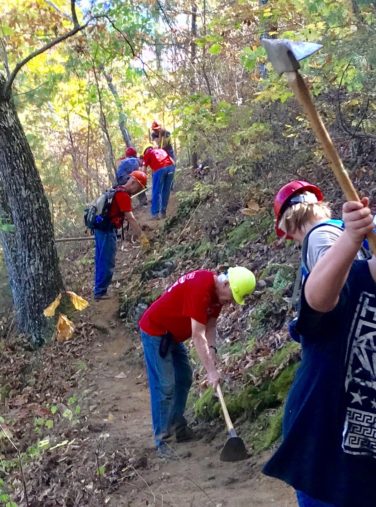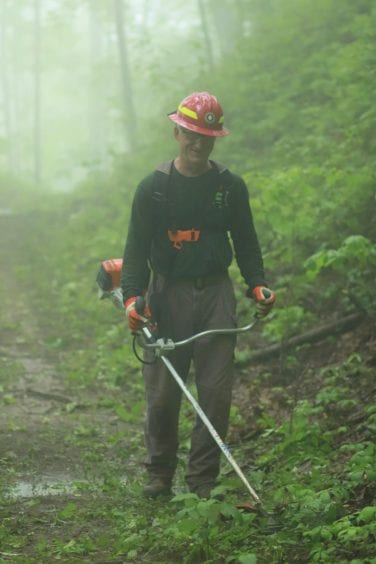1. Corridor Vegetation Clearance
The BMT official standard is a corridor cleared to four-feet wide and seven-feet high. Strive to keep the trail clear during the most active months of hiking, March – November. Note that tree branches grow slowly and are less trouble to hikers than briars and thorny blackberries which grow much faster. For this reason, it is recommended that branches and all cane and woody material be removed within the prescribed four-foot-wide by seven-foot-high corridor window during the dormant season. Most sections will need another pass after the spring growing season, typically in late May or June (depending on elevation, rainfall and temperatures). Some sections will require a third pass in August. In the growing season, try to maintain the corridor window at a minimum of two-feet-wide by six-feet-high, though closer to the four-foot x seven-foot standard, the better.
2. Treadway
The BMT goal is a treadway between 12 and 18 inches in width. In steep, rocky areas, the treadway may be narrower. When walking your section, it is good practice to knock small branches and other trip hazards off to the side. This helps keep the treadway well-defined and safer for hikers. Leaves and duff should be left on the trail as they help prevent erosion. Waterbars should be cleaned at least annually and reconstructed as needed (a fire rake is useful for this). When a stretch of sidehill trail becomes worn or eroded, rehabilitate it (a Pulaski or hoe is useful for this). Ask your Maintenance Director for help! Refreshing a substantial section of sidehilling is a great monthly work trip.
3. Blowdowns
You will normally be able to handle minor blowdowns (up to six inches in diameter). Experienced maintainers can handle larger trees using a bow saw. Never attempt to saw out a blowdown you are not absolutely certain you can handle safely. Larger trees can weigh several tons and shift unpredictably as they are cut. If in doubt, ask for help (give specific location information). Blowdowns two to five feet high should be given top priority. Chainsaws and crosscut saws can be used only by those who have taken the appropriate USFS training (usually a two-day class for each) as well as have received up-to-date First Aid and CPR training from the American Red Cross or the American Heart Association. Chainsaw chaps are required when using a chainsaw or crosscut saw.
4. Blazing
The BMT standard is a white, five-inch-wide by seven-inch-high, painted blaze placed approximately five feet off the ground.
Existing ‘glob blazes’ can be revised to specs by tracing the outline on the existing paint. Then use a scraper to remove the overrun.
All intersections, turns or places where the treadway is not well defined, as well as points of potential confusion should be blazed. Look at the trail as if you were a hiker who had never seen it before. Otherwise, blazes should be spaced about 200 yards apart (approximately three minutes of hiking). If not already blazed to specifications, try to have your section in compliance within two years. After this, one blazing trip per year should keep your blazes in top shape.
Double Blazes: A double-blaze (one BMT diamond directly above the other) indicates a “change-of-direction or heads-up!”. It should be the last mark before the turn, intersection, etc. and should be placed just before it, not in it. Standing in the turn, intersection, etc., one should readily be able to see the single blaze leading away and a reassurance blaze should appear shortly after. Be sure to check both directions of travel. Do not blaze every turn! Double-blazing is required only where there is a possibility of missing a turn. For example, a switchback turn with no connection to any existing road or trail would not be blazed.
It is the responsibility of BMTA’s Blaze Team to ensure that all sections of the BMT are blazed correctly.
If you’re interested in learning how to blaze the trail and want to become a member of the Blaze Team, contact the Blaze Team Leader.





